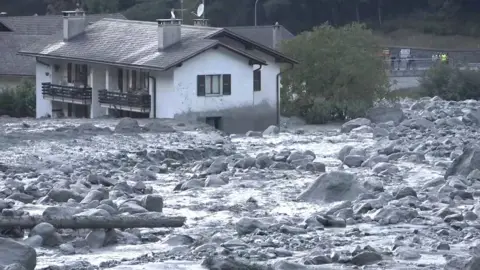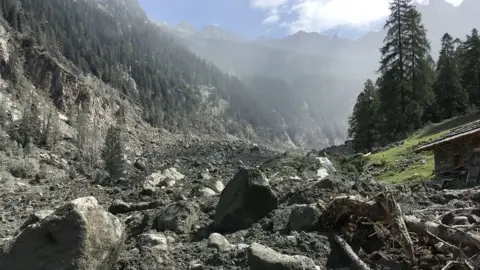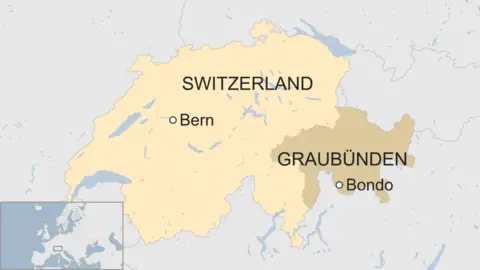Switzerland landslide: Are the Alps melting?
 Reuters
ReutersA massive rockslide in Switzerland's Val Bondasca was not a complete surprise. Many parts of Switzerland, two thirds of which is mountainous, are at risk of avalanches and landslides.
Communities in the Alps have been protecting themselves against such natural hazards for years.
Before Wednesday's landslide, sensors on the Piz Cenaglo, high above the Bondasca valley, had already shown that the rock mass was moving. That warning triggered the automatic closure of some sections of road.
The village of Bondo had a narrow escape. The four million cubic metres (141m cubic feet) of mud and rock which thundered down the mountain ended up just centimetres from people's homes.
That wasn't just luck. Bondo has a concrete barrier to protect it from the full force of a landslide, and the river bed in the Bondasca Valley has been widened in the hope of channelling landslides away from populated areas.
But the size of Wednesday's slide was a shock, and some scientists are now warning that the alpine regions can expect more events like this in the future.
Permafrost thaw
The reason is that the high mountains are not as cold as they once were. Marcia Phillips, a permafrost researcher with Switzerland's Federal Institute for Snow and Avalanche Research, has been analysing temperatures all over the Alps.
"We have bore holes at different depths in different terrain and the ones that are in rock walls are showing a distinct warming over the last 10 to 20 years," she explained.
That would not be a problem if the rock was simply rock, but the rock in large sections of the Swiss Alps is cracked and fractured - between the layers of rock there are layers of permafrost. Ice in fact, but ice that is not supposed to melt.
"We have a problem if the temperature rises above -1.5C because the permafrost has a stabilising function," Ms Phillips said.
Compounding the weakening permafrost is another phenomenon associated with global warming - Switzerland's glaciers are noticeably retreating.
The glacier at the base of Piz Cenaglo provided additional stability to the rock above it, but that glacier has shrunk in recent years. So precarious had the mountain become that Marcia and her colleagues had given up on borehole testing and instead resorted to remote monitoring.
"It is cracked and unstable up there," she explained, "It was just too dangerous."
Infrastructure fears
Another headache associated with thawing permafrost is the possible risk to winter tourism. The stanchions of cable cars and chairlifts are very often anchored in permafrost.
The Swiss government already requires intensive monitoring of cable car infrastructure. Lift operators must check regularly for any movement or creep.
Marcia Phillips suggests that, if temperatures do continue to rise, changes may have to be made.
"I could foresee some having to be closed down or rebuilt," she said.
 AFP
AFPIn preparation, the avalanche institute has already produced a book "Building in Permafrost" with guidelines on how to build safely.
"It is possible but very, very expensive," said Ms Phillips.
That is not good news for Switzerland's tourism resorts, already suffering financially because of the strength of the Swiss franc.
For now, though, the focus remains on finding the eight people still missing from Wednesday's landslide, and on protecting those who live in the Bondasca Valley.
The residents of Bondo have been told they cannot go home yet. Four million cubic metres of rock came down but another million, very unstable, still looms above the village.

